filter
Filter disturbances through vector error-correction (VEC) model
Syntax
Description
Y = filter(Mdl,Z)Y containing the multivariate
response series, which results from filtering the underlying input numeric array
Z containing the multivariate disturbance series. The
series in Z are associated with the model innovations
process through the fully specified VEC(p – 1) model
Mdl.
Tbl2 = filter(Mdl,Tbl1,Presample=Presample)Tbl2 containing the multivariate response series, which results from filtering the underlying multivariate disturbance series in the input table or timetable Tbl1. filter initializes the response series using the required table or timetable of presample data in Presample. Variables in Tbl1 are associated with the model innovations process through Mdl. (since R2022b)
filter selects the variables in Mdl.SeriesNames or all variables in Tbl1. To select different disturbance variables in Tbl1 to filter through the model, use the DisturbanceVariables name-value argument. filter selects the same variables for Presample by default, but you can select different variables by using the PresampleResponseVariables name-value argument.
[___] = filter(___,
specifies options using one or more name-value arguments in
addition to any of the input argument combinations in previous syntaxes.
Name,Value)filter returns the output argument combination for the
corresponding input arguments. For example, filter(Mdl,Z,Y0=PS,X=Exo) filters
the numeric array of disturbances Z through the
VEC(p – 1) model Mdl, and specifies
the numeric array of presample response data PS and the
numeric matrix of exogenous predictor data Exo for the model
regression component.
Examples
Consider a VEC model for the following seven macroeconomic series. Then, fit the model to the data and filter disturbances through the fitted model. Supply the disturbances as a numeric matrix.
Gross domestic product (GDP)
GDP implicit price deflator
Paid compensation of employees
Nonfarm business sector hours of all persons
Effective federal funds rate
Personal consumption expenditures
Gross private domestic investment
Suppose that a cointegrating rank of 4 and one short-run term are appropriate, that is, consider a VEC(1) model.
Load the Data_USEconVECModel data set.
load Data_USEconVECModelFor more information on the data set and variables, enter Description at the command line.
Determine whether the data needs to be preprocessed by plotting the series on separate plots.
figure tiledlayout(2,2) nexttile plot(FRED.Time,FRED.GDP) title("Gross Domestic Product") ylabel("Index") xlabel("Date") nexttile plot(FRED.Time,FRED.GDPDEF) title("GDP Deflator") ylabel("Index") xlabel("Date") nexttile plot(FRED.Time,FRED.COE) title("Paid Compensation of Employees") ylabel("Billions of $") xlabel("Date") nexttile plot(FRED.Time,FRED.HOANBS) title("Nonfarm Business Sector Hours") ylabel("Index") xlabel("Date")
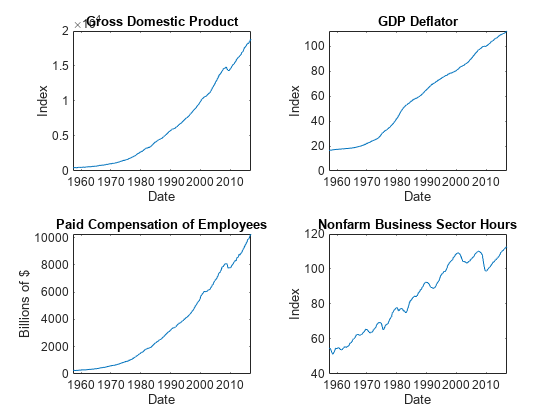
figure tiledlayout(2,2) nexttile plot(FRED.Time,FRED.FEDFUNDS) title("Federal Funds Rate") ylabel("Percent") xlabel("Date") nexttile plot(FRED.Time,FRED.PCEC) title("Consumption Expenditures") ylabel("Billions of $") xlabel("Date") nexttile plot(FRED.Time,FRED.GPDI) title("Gross Private Domestic Investment") ylabel("Billions of $") xlabel("Date")
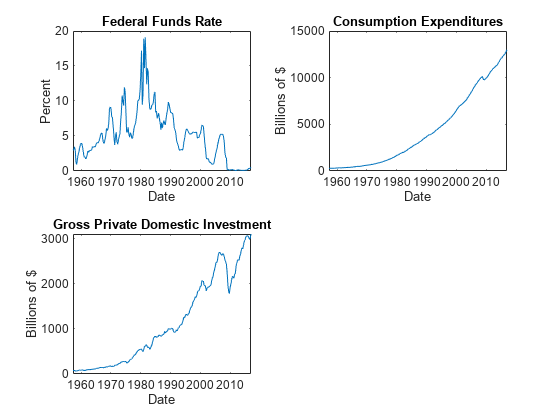
Stabilize all series, except the federal funds rate, by applying the log transform. Scale the resulting series by 100 so that all series are on the same scale.
FRED.GDP = 100*log(FRED.GDP); FRED.GDPDEF = 100*log(FRED.GDPDEF); FRED.COE = 100*log(FRED.COE); FRED.HOANBS = 100*log(FRED.HOANBS); FRED.PCEC = 100*log(FRED.PCEC); FRED.GPDI = 100*log(FRED.GPDI);
Create a VEC(1) model using the shorthand syntax. Specify the variable names.
Mdl = vecm(7,4,1); Mdl.SeriesNames = FRED.Properties.VariableNames
Mdl =
vecm with properties:
Description: "7-Dimensional Rank = 4 VEC(1) Model with Linear Time Trend"
SeriesNames: "GDP" "GDPDEF" "COE" ... and 4 more
NumSeries: 7
Rank: 4
P: 2
Constant: [7×1 vector of NaNs]
Adjustment: [7×4 matrix of NaNs]
Cointegration: [7×4 matrix of NaNs]
Impact: [7×7 matrix of NaNs]
CointegrationConstant: [4×1 vector of NaNs]
CointegrationTrend: [4×1 vector of NaNs]
ShortRun: {7×7 matrix of NaNs} at lag [1]
Trend: [7×1 vector of NaNs]
Beta: [7×0 matrix]
Covariance: [7×7 matrix of NaNs]
Mdl is a vecm model object. All properties containing NaN values correspond to parameters to be estimated given data.
Estimate the model using the entire data set and the default options. By default, estimate uses the first p = 2 observations as presample data.
EstMdl = estimate(Mdl,FRED.Variables)
EstMdl =
vecm with properties:
Description: "7-Dimensional Rank = 4 VEC(1) Model"
SeriesNames: "GDP" "GDPDEF" "COE" ... and 4 more
NumSeries: 7
Rank: 4
P: 2
Constant: [14.1329 8.77841 -7.20359 ... and 4 more]'
Adjustment: [7×4 matrix]
Cointegration: [7×4 matrix]
Impact: [7×7 matrix]
CointegrationConstant: [-28.6082 -109.555 77.0912 ... and 1 more]'
CointegrationTrend: [4×1 vector of zeros]
ShortRun: {7×7 matrix} at lag [1]
Trend: [7×1 vector of zeros]
Beta: [7×0 matrix]
Covariance: [7×7 matrix]
EstMdl is an estimated vecm model object. It is fully specified because all parameters have known values. By default, estimate imposes the constraints of the H1 Johansen VEC model form by removing the cointegrating trend and linear trend terms from the model. Parameter exclusion from estimation is equivalent to imposing equality constraints to zero.
Generate a numobs-by-7 series of random Gaussian distributed values, where numobs is the number of observations in the data minus p.
numobs = size(FRED,1) - Mdl.P;
rng(1) % For reproducibility
Z = randn(numobs,Mdl.NumSeries);To simulate responses, filter the disturbances through the estimated model. Specify the first p = 2 observations as presample data.
Y = filter(EstMdl,Z,Y0=FRED{1:2,:});Y is a 238-by-7 matrix of simulated responses. Columns correspond to the variable names in EstMdl.SeriesNames.
Plot the simulated and true responses.
figure tiledlayout(2,2) nexttile plot(FRED.Time(3:end),[FRED.GDP(3:end) Y(:,1)]) title("Gross Domestic Product") ylabel("Index (scaled, log)") xlabel("Date") legend("Simulation","True","Location","Best") nexttile plot(FRED.Time(3:end),[FRED.GDPDEF(3:end) Y(:,2)]) title("GDP Deflator") ylabel("Index (scaled, log)") xlabel("Date") legend("Simulation","True","Location","Best") nexttile plot(FRED.Time(3:end),[FRED.COE(3:end) Y(:,3)]) title("Paid Compensation of Employees") ylabel("Billions of $ (scaled, log)") xlabel("Date") legend("Simulation","True","Location","Best") nexttile plot(FRED.Time(3:end),[FRED.HOANBS(3:end) Y(:,4)]) title("Nonfarm Business Sector Hours") ylabel("Index (scaled, log)") xlabel("Date") legend("Simulation","True","Location","Best")
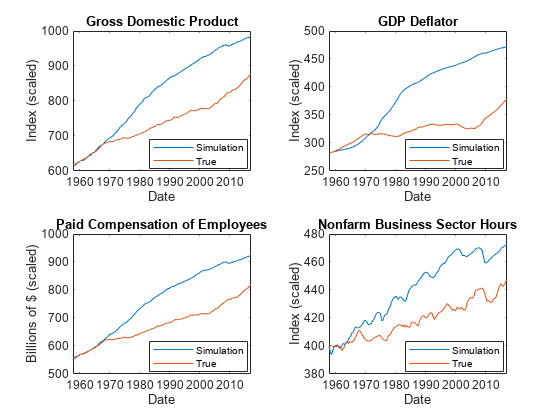
figure tiledlayout(2,2) nexttile plot(FRED.Time(3:end),[FRED.FEDFUNDS(3:end) Y(:,5)]) title("Federal Funds Rate") ylabel("Percent") xlabel("Date") nexttile plot(FRED.Time(3:end),[FRED.PCEC(3:end) Y(:,6)]) title("Consumption Expenditures") ylabel("Billions of $ (scaled, log)") xlabel("Date") nexttile plot(FRED.Time(3:end),[FRED.GPDI(3:end) Y(:,7)]) title("Gross Private Domestic Investment") ylabel("Billions of $ (scaled, log)") xlabel("Date")
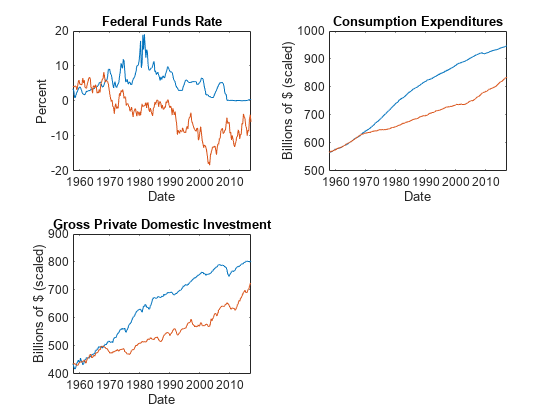
Consider this VEC(1) model for three hypothetical response series.
The innovations are multivariate Gaussian with a mean of 0 and the covariance matrix
Create variables for the parameter values.
Adjustment = [-0.3 0.3; -0.2 0.1; -1 0];
Cointegration = [0.1 -0.7; -0.2 0.5; 0.2 0.2];
ShortRun = {[0. 0.1 0.2; 0.2 -0.2 0; 0.7 -0.2 0.3]};
Constant = [-1; -3; -30];
Trend = [0; 0; 0];
Covariance = [1.3 0.4 1.6; 0.4 0.6 0.7; 1.6 0.7 5];Create a vecm model object representing the VEC(1) model using the appropriate name-value pair arguments.
Mdl = vecm('Adjustment',Adjustment,'Cointegration',Cointegration,... 'Constant',Constant,'ShortRun',ShortRun,'Trend',Trend,... 'Covariance',Covariance)
Mdl =
vecm with properties:
Description: "3-Dimensional Rank = 2 VEC(1) Model"
SeriesNames: "Y1" "Y2" "Y3"
NumSeries: 3
Rank: 2
P: 2
Constant: [-1 -3 -30]'
Adjustment: [3×2 matrix]
Cointegration: [3×2 matrix]
Impact: [3×3 matrix]
CointegrationConstant: [2×1 vector of NaNs]
CointegrationTrend: [2×1 vector of NaNs]
ShortRun: {3×3 matrix} at lag [1]
Trend: [3×1 vector of zeros]
Beta: [3×0 matrix]
Covariance: [3×3 matrix]
Mdl is, effectively, a fully specified vecm model object. That is, the cointegration constant and linear trend are unknown. However, they are not needed for simulating observations or forecasting, given that the overall constant and trend parameters are known.
Generate 1000 paths of 100 observations from a 3-D Gaussian distribution. numobs is the number of observations in the data without any missing values.
numobs = 100; numpaths = 1000; rng(1); Z = randn(numobs,Mdl.NumSeries,numpaths);
Filter the disturbances through the estimated model. Return the innovations (scaled disturbances).
[Y,E] = filter(Mdl,Z);
Y and E are 100-by-3-by-1000 matrices of filtered responses and scaled disturbances, respectively.
For each time point, compute the mean vector of the filtered responses among all paths.
MeanFilt = mean(Y,3);
MeanFilt is a 100-by-3 matrix containing the average of the filtered responses at each time point.
Plot the filtered responses and their averages.
figure; for j = 1:Mdl.NumSeries subplot(2,2,j) plot(squeeze(Y(:,j,:)),'Color',[0.8,0.8,0.8]) title(Mdl.SeriesNames{j}); hold on plot(MeanFilt(:,j)); xlabel('Time index') hold off end
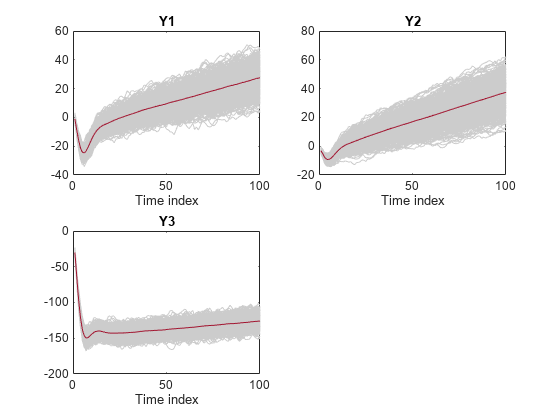
Since R2022b
Fit a VEC(1) model to seven macroeconomic series. Then, simulate responses by filtering multiple random paths of Gaussian distributed disturbances through the estimated model. Supply the disturbances in a timetable. This example is based on Fit VEC(1) Model to Matrix of Response Data.
Load and Preprocess Data
Load the Data_USEconVECModel data set.
load Data_USEconVECModel
head(FRED) Time GDP GDPDEF COE HOANBS FEDFUNDS PCEC GPDI
___________ _____ ______ _____ ______ ________ _____ ____
31-Mar-1957 470.6 16.485 260.6 54.756 2.96 282.3 77.7
30-Jun-1957 472.8 16.601 262.5 54.639 3 284.6 77.9
30-Sep-1957 480.3 16.701 265.1 54.375 3.47 289.2 79.3
31-Dec-1957 475.7 16.711 263.7 53.249 2.98 290.8 71
31-Mar-1958 468.4 16.892 260.2 52.043 1.2 290.3 66.7
30-Jun-1958 472.8 16.94 259.9 51.297 0.93 293.2 65.1
30-Sep-1958 486.7 17.043 267.7 51.908 1.76 298.3 72
31-Dec-1958 500.4 17.123 272.7 52.683 2.42 302.2 80
Stabilize all series, except the federal funds rate, by applying the log transform. Scale the resulting series by 100 so that all series are on the same scale.
FRED.GDP = 100*log(FRED.GDP); FRED.GDPDEF = 100*log(FRED.GDPDEF); FRED.COE = 100*log(FRED.COE); FRED.HOANBS = 100*log(FRED.HOANBS); FRED.PCEC = 100*log(FRED.PCEC); FRED.GPDI = 100*log(FRED.GPDI); numobs = height(FRED)
numobs = 240
Prepare Timetable for Estimation
When you plan to supply a timetable directly to estimate, you must ensure it has all the following characteristics:
All selected response variables are numeric and do not contain any missing values.
The timestamps in the
Timevariable are regular, and they are ascending or descending.
Remove all missing values from the table.
DTT = rmmissing(FRED); numobs = height(DTT)
numobs = 240
DTT does not contain any missing values.
Determine whether the sampling timestamps have a regular frequency and are sorted.
areTimestampsRegular = isregular(DTT,"quarters")areTimestampsRegular = logical
0
areTimestampsSorted = issorted(DTT.Time)
areTimestampsSorted = logical
1
areTimestampsRegular = 0 indicates that the timestamps of DTT are irregular. areTimestampsSorted = 1 indicates that the timestamps are sorted. Macroeconomic series in this example are timestamped at the end of the month. This quality induces an irregularly measured series.
Remedy the time irregularity by shifting all dates to the first day of the quarter.
dt = DTT.Time; dt = dateshift(dt,"start","quarter"); DTT.Time = dt; areTimestampsRegular = isregular(DTT,"quarters")
areTimestampsRegular = logical
1
DTT is regular with respect to time.
Fit Model to Data
Create a VEC(1) model using the shorthand syntax. Specify the variable names.
Mdl = vecm(7,4,1); Mdl.SeriesNames = string(FRED.Properties.VariableNames);
Estimate the model. Pass the entire timetable DTT. By default, estimate selects the response variables in Mdl.SeriesNames to fit to the model. Alternatively, you can use the ResponseVariables name-value argument.
EstMdl = estimate(Mdl,DTT);
Simulate Paths of Disturbances
Generate a numobs-by-numseries-by-numpaths array of independent random Gaussian distributed values, where numobs is the number of observations in the data, numseries the number of response series 7, and numpaths is 100. Add the matrices of simulated paths into the data set DTT.
rng(1) % For reproducibility numobs = height(DTT); numseries = EstMdl.NumSeries; numpaths = 100; Z = mvnrnd(zeros(numseries,1),eye(numseries),numobs*numpaths); Z = reshape(Z,numobs,numseries,numpaths); for j = 1:numseries DTT = addvars(DTT,squeeze(Z(:,j,:)), ... NewVariableNames="Z_" + EstMdl.SeriesNames{j}); end head(DTT)
Time GDP GDPDEF COE HOANBS FEDFUNDS PCEC GPDI Z_GDP Z_GDPDEF Z_COE Z_HOANBS Z_FEDFUNDS Z_PCEC Z_GPDI
___________ ______ ______ ______ ______ ________ ______ ______ ____________ ____________ ____________ ____________ ____________ ____________ ____________
01-Jan-1957 615.4 280.25 556.3 400.29 2.96 564.3 435.29 1×100 double 1×100 double 1×100 double 1×100 double 1×100 double 1×100 double 1×100 double
01-Apr-1957 615.87 280.95 557.03 400.07 3 565.11 435.54 1×100 double 1×100 double 1×100 double 1×100 double 1×100 double 1×100 double 1×100 double
01-Jul-1957 617.44 281.55 558.01 399.59 3.47 566.71 437.32 1×100 double 1×100 double 1×100 double 1×100 double 1×100 double 1×100 double 1×100 double
01-Oct-1957 616.48 281.61 557.48 397.5 2.98 567.26 426.27 1×100 double 1×100 double 1×100 double 1×100 double 1×100 double 1×100 double 1×100 double
01-Jan-1958 614.93 282.68 556.15 395.21 1.2 567.09 420.02 1×100 double 1×100 double 1×100 double 1×100 double 1×100 double 1×100 double 1×100 double
01-Apr-1958 615.87 282.97 556.03 393.76 0.93 568.09 417.59 1×100 double 1×100 double 1×100 double 1×100 double 1×100 double 1×100 double 1×100 double
01-Jul-1958 618.76 283.57 558.99 394.95 1.76 569.81 427.67 1×100 double 1×100 double 1×100 double 1×100 double 1×100 double 1×100 double 1×100 double
01-Oct-1958 621.54 284.04 560.84 396.43 2.42 571.11 438.2 1×100 double 1×100 double 1×100 double 1×100 double 1×100 double 1×100 double 1×100 double
Filter Disturbances Through Model
When you filter disturbances by using a timetable, filter requires a presample. Split the timetable into presample and in-sample data sets. The presample data is the initial EstMdl.P observations, and the in-sample data set contains the remaining observations.
Presample = DTT(1:EstMdl.P,:); InSample = DTT((EstMdl.P + 1):end,:);
Simulate response paths by filtering the in-sample disturbances through the estimated model. Specify the variable names of the disturbance series, the presample data, and the response variable names in the presample.
dnames = string(DTT.Properties.VariableNames); idx = startsWith(dnames,"Z_"); dnames = dnames(idx); Tbl2 = filter(EstMdl,InSample,DisturbanceVariables=dnames, ... Presample=Presample,PresampleResponseVariables=EstMdl.SeriesNames); size(Tbl2)
ans = 1×2
238 28
head(Tbl2)
Time GDP GDPDEF COE HOANBS FEDFUNDS PCEC GPDI Z_GDP Z_GDPDEF Z_COE Z_HOANBS Z_FEDFUNDS Z_PCEC Z_GPDI GDP_Responses GDPDEF_Responses COE_Responses HOANBS_Responses FEDFUNDS_Responses PCEC_Responses GPDI_Responses GDP_Innovations GDPDEF_Innovations COE_Innovations HOANBS_Innovations FEDFUNDS_Innovations PCEC_Innovations GPDI_Innovations
___________ ______ ______ ______ ______ ________ ______ ______ ____________ ____________ ____________ ____________ ____________ ____________ ____________ _____________ ________________ _____________ ________________ __________________ ______________ ______________ _______________ __________________ _______________ __________________ ____________________ ________________ ________________
01-Jul-1957 617.44 281.55 558.01 399.59 3.47 566.71 437.32 1×100 double 1×100 double 1×100 double 1×100 double 1×100 double 1×100 double 1×100 double 1×100 double 1×100 double 1×100 double 1×100 double 1×100 double 1×100 double 1×100 double 1×100 double 1×100 double 1×100 double 1×100 double 1×100 double 1×100 double 1×100 double
01-Oct-1957 616.48 281.61 557.48 397.5 2.98 567.26 426.27 1×100 double 1×100 double 1×100 double 1×100 double 1×100 double 1×100 double 1×100 double 1×100 double 1×100 double 1×100 double 1×100 double 1×100 double 1×100 double 1×100 double 1×100 double 1×100 double 1×100 double 1×100 double 1×100 double 1×100 double 1×100 double
01-Jan-1958 614.93 282.68 556.15 395.21 1.2 567.09 420.02 1×100 double 1×100 double 1×100 double 1×100 double 1×100 double 1×100 double 1×100 double 1×100 double 1×100 double 1×100 double 1×100 double 1×100 double 1×100 double 1×100 double 1×100 double 1×100 double 1×100 double 1×100 double 1×100 double 1×100 double 1×100 double
01-Apr-1958 615.87 282.97 556.03 393.76 0.93 568.09 417.59 1×100 double 1×100 double 1×100 double 1×100 double 1×100 double 1×100 double 1×100 double 1×100 double 1×100 double 1×100 double 1×100 double 1×100 double 1×100 double 1×100 double 1×100 double 1×100 double 1×100 double 1×100 double 1×100 double 1×100 double 1×100 double
01-Jul-1958 618.76 283.57 558.99 394.95 1.76 569.81 427.67 1×100 double 1×100 double 1×100 double 1×100 double 1×100 double 1×100 double 1×100 double 1×100 double 1×100 double 1×100 double 1×100 double 1×100 double 1×100 double 1×100 double 1×100 double 1×100 double 1×100 double 1×100 double 1×100 double 1×100 double 1×100 double
01-Oct-1958 621.54 284.04 560.84 396.43 2.42 571.11 438.2 1×100 double 1×100 double 1×100 double 1×100 double 1×100 double 1×100 double 1×100 double 1×100 double 1×100 double 1×100 double 1×100 double 1×100 double 1×100 double 1×100 double 1×100 double 1×100 double 1×100 double 1×100 double 1×100 double 1×100 double 1×100 double
01-Jan-1959 623.66 284.31 563.55 398.35 2.8 573.62 442.12 1×100 double 1×100 double 1×100 double 1×100 double 1×100 double 1×100 double 1×100 double 1×100 double 1×100 double 1×100 double 1×100 double 1×100 double 1×100 double 1×100 double 1×100 double 1×100 double 1×100 double 1×100 double 1×100 double 1×100 double 1×100 double
01-Apr-1959 626.19 284.46 565.91 400.24 3.39 575.54 449.31 1×100 double 1×100 double 1×100 double 1×100 double 1×100 double 1×100 double 1×100 double 1×100 double 1×100 double 1×100 double 1×100 double 1×100 double 1×100 double 1×100 double 1×100 double 1×100 double 1×100 double 1×100 double 1×100 double 1×100 double 1×100 double
Tbl2 is a 238-by-2 matrix of in-sample data, paths of simulated disturbances, paths of filtered responses (variables names appended with _Responses, and paths of innovations (variables with name appended with _Innovations).
rnames = string(Tbl2.Properties.VariableNames); idx = endsWith(rnames,"_Responses"); rnames = rnames(idx); figure tiledlayout(2,2) for j = 1:4 nexttile p1 = plot(Tbl2.Time,Tbl2{:,rnames(j)},Color=[0.5 0.5 0.5]); hold on p2 = plot(Tbl2.Time,Tbl2{:,Mdl.SeriesNames(j)},LineWidth=2); title(Mdl.SeriesNames(j)) xlabel("Date") legend([p1(1) p2],["Simulated" "Observed"]) end
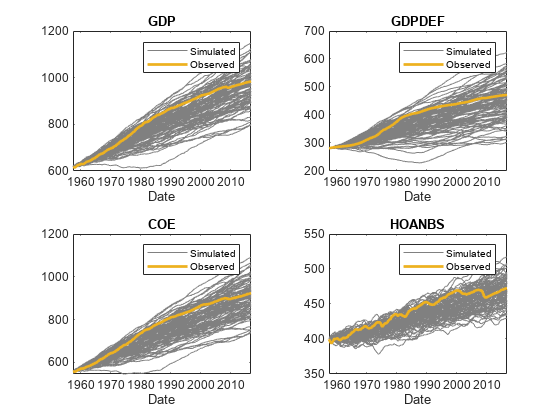
figure tiledlayout(2,2) for j = 5:7 nexttile p1 = plot(Tbl2.Time,Tbl2{:,rnames(j)},Color=[0.5 0.5 0.5]); hold on p2 = plot(Tbl2.Time,Tbl2{:,Mdl.SeriesNames(j)},LineWidth=2); title(Mdl.SeriesNames(j)) xlabel("Date") legend([p1(1) p2],["Simulated" "Observed"]) end
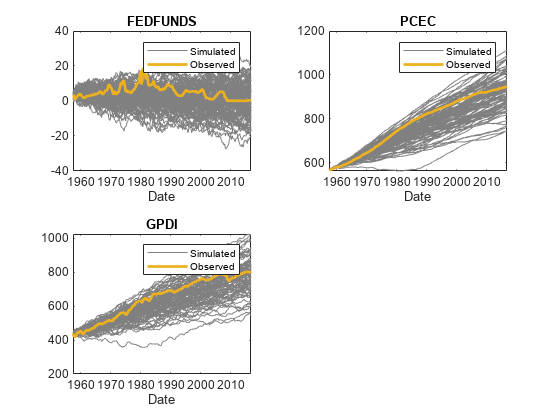
Input Arguments
Underlying multivariate disturbance series
zt associated with the model innovations
process εt, specified as a
numobs-by-numseries numeric matrix or a
numobs-by-numseries-by-numpaths
numeric array.
numobs is the sample size. numseries is the
number of disturbance series (Mdl.NumSeries).
numpaths is the number of disturbance paths.
Rows correspond to sampling times, and the last row contains the latest set of disturbances.
Columns correspond to individual disturbance series for response variables.
Pages correspond to separate, independent paths. For a numeric matrix,
Z is a single numseries-dimensional path of
disturbance series. For a 3-D array, each page of Z represents a
separate numseries-dimensional path. Among all pages, disturbances in
corresponding rows occur at the same time.
The Scale name-value argument specifies whether to scale the
disturbances before filter filters them through
Mdl. For more details, see Scale.
Data Types: double
Since R2022b
Time series data containing observed disturbance variables
zt, associated
with the model innovations process
εt, or predictor variables
xt, specified as a
table or timetable with numvars variables and
numobs rows. You can optionally select
numseries disturbance variables or
numpreds predictor variables by using the
DisturbanceVariables or
PredictorVariables name-value arguments,
respectively.
Each selected disturbance variable is a
numobs-by-numpaths numeric
matrix, and each predictor variable is a numeric vector. Each row is an
observation, and measurements in each row occur simultaneously.
Each path (column) of a disturbance variable is independent of all others, but
path jjnumpaths. Each selected predictor variable
contains one path, which filter applies to all
paths.
If Tbl1 is a timetable, it must represent a sample with a
regular datetime time step (see isregular), and the
datetime vector Tbl1.Time must be ascending or
descending.
If Tbl1 is a table, the last row contains the latest
observation.
The Scale name-value argument specifies whether to scale
the disturbances before filter filters them
through Mdl. For more details, see
Scale.
Since R2022b
Presample data that provides initial values for the model Mdl,
specified as a table or timetable, the same type as Tbl1, with
numprevars variables and numpreobs rows.
Presample is required when you supply a table or timetable of data
Tbl1.
Each row is a presample observation, and measurements in each row, among all paths, occur
simultaneously. numpreobs must be at least Mdl.P. If you
supply more rows than necessary, filter uses the latest
Mdl.P observations only.
Each variable is a numpreobs-by-numprepaths numeric
matrix. Variables correspond to the response series associated with the respective disturbance
in Tbl1. To control presample variable selection, see the optional
PresampleResponseVariables name-value argument.
For each variable, columns are separate, independent paths.
If variables are vectors,
filterapplies them to each path inTbl1to produce the filtered responses inTbl2. Therefore, all paths of filtered responses derive from common initial conditions.Otherwise, for each variable
VarkjfilterappliesPresample.to produceVark(:,j)Tbl2.. Variables must have at leastVark(:,j)numpathscolumns, andfilteruses only the firstnumpathscolumns.
If Presample is a timetable, all the following conditions must be true:
Presamplemust represent a sample with a regular datetime time step (seeisregular).The inputs
Tbl1andPresamplemust be consistent in time such thatPresampleimmediately precedesTbl1with respect to the sampling frequency and order.The datetime vector of sample timestamps
Presample.Timemust be ascending or descending.
If Presample is a table, the last row contains the latest presample
observation.
Name-Value Arguments
Specify optional pairs of arguments as
Name1=Value1,...,NameN=ValueN, where Name is
the argument name and Value is the corresponding value.
Name-value arguments must appear after other arguments, but the order of the
pairs does not matter.
Before R2021a, use commas to separate each name and value, and enclose
Name in quotes.
Example: filter(Mdl,Z,Y0=PS,X=Exo) filters the numeric array of
disturbances Z through the VEC(p – 1) model
Mdl, and specifies the numeric array of presample response
data PS and the numeric matrix of exogenous predictor data
Exo for the model regression component.
Since R2022b
Variables to select from Tbl1 to treat as disturbance variables
zt, specified as one of the following
data types:
String vector or cell vector of character vectors containing
numseriesvariable names inTbl1.Properties.VariableNamesA length
numseriesvector of unique indices (integers) of variables to select fromTbl1.Properties.VariableNamesA length
numvarslogical vector, whereDisturbanceVariables(selects variablej) = truejTbl1.Properties.VariableNames, andsum(DisturbanceVariables)isnumseries
The selected variables must be numeric vectors (single path) or matrices (columns
represent multiple independent paths) of the same width, and cannot contain missing
values (NaN).
If the number of variables in Tbl1 matches
Mdl.NumSeries, the default specifies all variables in
Tbl1. If the number of variables in Tbl1
exceeds Mdl.NumSeries, the default matches variables in
Tbl1 to names in Mdl.SeriesNames.
Example: DisturbanceVariables=["GDP" "CPI"]
Example: DisturbanceVariables=[true false true false] or
DisturbanceVariable=[1 3] selects the first and third table
variables as the disturbance variables.
Data Types: double | logical | char | cell | string
Presample responses that provide initial values for the model
Mdl, specified as a
numpreobs-by-numseries numeric matrix or a
numpreobs-by-numseries-by-numprepaths
numeric array. Use Y0 only when you supply a numeric array of
disturbance data Z.
numpreobs is the number of presample observations.
numprepaths is the number of presample response paths.
Each row is a presample observation, and measurements in each row, among all pages,
occur simultaneously. The last row contains the latest presample observation.
Y0 must have at least Mdl.P rows. If you
supply more rows than necessary, filter uses the latest
Mdl.P observations only.
Each column corresponds to the response series associated with the respective
disturbance in Z.
Pages correspond to separate, independent paths.
If
Y0is a matrix,filterapplies it to each path (page) to produce the filtered responsesY. Therefore, all paths inYderive from common initial conditions.Otherwise,
filterappliesY0(:,:,to producej)Y(:,:,.j)Y0must have at leastnumpathspages, andfilteruses only the firstnumpathspages.
By default, filter sets any necessary presample observations.
For stationary VAR processes without regression components,
filteruses the unconditional meanFor nonstationary processes or models containing a regression component,
filtersets presample observations to an array composed of zeros.
Data Types: double
Since R2022b
Variables to select from Presample to use for presample data,
specified as one of the following data types:
String vector or cell vector of character vectors containing
numseriesvariable names inPresample.Properties.VariableNamesA length
numseriesvector of unique indices (integers) of variables to select fromPresample.Properties.VariableNamesA length
numvarslogical vector, wherePresampleResponseVariables(selects variablej) = truejPresample.Properties.VariableNames, andsum(PresampleResponseVariables)isnumseries
The selected variables must be numeric vectors (single path) or matrices (columns
represent multiple independent paths) of the same width, and cannot contain missing
values (NaN).
PresampleResponseNames does not need to contain the same names as
in Tbl1; filter uses the data in selected
variable PresampleResponseVariables( as
a presample for the response variable corresponding to
j)DisturbanceVariables(.j)
The default specifies the same response variables as those selected from
Tbl1 (see DisturbanceVariables).
Example: PresampleResponseVariables=["GDP" "CPI"]
Example: PresampleResponseVariables=[true false true false] or
PresampleResponseVariable=[1 3] selects the first and third table
variables for presample data.
Data Types: double | logical | char | cell | string
Predictor data xt for the regression
component in the model, specified as a numeric matrix containing
numpreds columns. Use X only when you supply a
numeric array of disturbance data Z.
numpreds is the number of predictor variables
(size(Mdl.Beta,2)).
Each row corresponds to an observation, and measurements in each row occur
simultaneously. The last row contains the latest observation. X must
have at least as many observations as Z. If you supply more rows than
necessary, filter uses only the latest observations.
filter does not use the regression component in the
presample period.
Each column is an individual predictor variable. All predictor variables are present in the regression component of each response equation.
filter applies X to each path (page) in
Z; that is, X represents one path of
observed predictors.
By default, filter excludes the regression component,
regardless of its presence in Mdl.
Data Types: double
Since R2022b
Variables to select from Tbl1 to treat as exogenous predictor variables
xt, specified as one of the following data types:
String vector or cell vector of character vectors containing
numpredsvariable names inTbl1.Properties.VariableNamesA length
numpredsvector of unique indices (integers) of variables to select fromTbl1.Properties.VariableNamesA length
numvarslogical vector, wherePredictorVariables(selects variablej) = truejTbl1.Properties.VariableNames, andsum(PredictorVariables)isnumpreds
The selected variables must be numeric vectors and cannot contain missing values
(NaN).
By default, filter excludes the regression component, regardless
of its presence in Mdl.
Example: PredictorVariables=["M1SL" "TB3MS" "UNRATE"]
Example: PredictorVariables=[true false true false] or
PredictorVariable=[1 3] selects the first and third table variables to
supply the predictor data.
Data Types: double | logical | char | cell | string
Flag indicating whether to scale disturbances by the lower triangular Cholesky factor of the model covariance matrix, specified as a value in this table. In the table:
| Value | Description |
|---|---|
true | E(:,:, =
L*Z(:,:,,
where L =
chol(Mdl.Covariance,"lower") |
false | No scale, E(:,:,
= Z(:,:, |
For each page j = 1,...,numpaths,
filter filters the
numobs-by-numseries matrix of innovations
E(:,:, through the
VAR(p) model j)Mdl using the specified
scale.
Example: Scale=false
Data Types: logical
Note
NaNvalues inZ,Y0, andXindicate missing values.filterremoves missing values from the data by list-wise deletion.If
Zis a 3-D array, thenfilterhorizontally concatenates the pages ofZto form anumobs-by-numpaths*numseriesmatrix.If a regression component is present, then
filterhorizontally concatenatesXtoZto form anumobs-by-(numpaths*numseries + numpreds)matrix.filterassumes that the last rows of each series occur at the same time.filterremoves any row that contains at least oneNaNfrom the concatenated data.filterapplies steps 1 and 3 to the presample paths inY0.
This process ensures that the filtered responses and innovations of each path are the same size and are based on the same observation times. In the case of missing observations, the results obtained from multiple paths of
Zcan differ from the results obtained from each path individually.This data reduction reduces the effective sample size.
filterissues an error when any table or timetable input contains missing values.
Output Arguments
Since R2022b
Multivariate filtered response yt and
innovation series εt, returned as a table or
timetable, the same data type as Tbl1.
filter returns Tbl2 only when you
supply the input Tbl1.
Tbl2 contains the following variables:
The filtered response variables yt. Each filtered response variable is a
numobs-by-numpathsnumeric matrix, with rows representing observations and columns representing independent paths, each corresponding to the input observations and paths inTbl1.filternames the filtered response for disturbance variableDisturbanceJTbl1DisturbanceJ_ResponsesTbl1to filter isGDP,Tbl2contains a variable for the corresponding filtered responses with the nameGDP_Responses.The innovation variables εt. Each innovation variable is a
numobs-by-numpathsnumeric matrix, with rows representing observations and columns representing independent paths, each corresponding to the input observations and paths inTbl1.filternames the innovation variable for disturbance variableDisturbanceJTbl1DisturbanceJ_InnovationsTbl1to filter isGDP,Tbl2contains a variable for the corresponding innovations with the nameGDP_Innovations.All variables
Tbl1.
If Tbl1 is a timetable, Tbl1 and
Tbl2 have the same row order, either ascending or
descending.
Algorithms
filtercomputesYandEusing this process for each pagejinZ.If
Scaleistrue, thenE(:,:,=j)L*Z(:,:,, wherej)L=chol(Mdl.Covariance,'lower'). Otherwise,E(:,:,=j)Z(:,:,. Set et =j)E(:,:,.j)Y(:,:,is yt in this system of equations.j)For variable definitions, see Vector Error-Correction Model.
filtergeneralizessimulate. Both functions filter a disturbance series through a model to produce responses and innovations. However, whereassimulategenerates a series of mean-zero, unit-variance, independent Gaussian disturbancesZto form innovationsE=L*Z,filterenables you to supply disturbances from any distribution.filteruses this process to determine the time origin t0 of models that include linear time trends.If you do not specify
Y0, then t0 = 0.Otherwise,
filtersets t0 tosize(Y0,1)–Mdl.P. Therefore, the times in the trend component are t = t0 + 1, t0 + 2,..., t0 +numobs, wherenumobsis the effective sample size (size(Y,1)afterfilterremoves missing values). This convention is consistent with the default behavior of model estimation in whichestimateremoves the firstMdl.Presponses, reducing the effective sample size. Althoughfilterexplicitly uses the firstMdl.Ppresample responses inY0to initialize the model, the total number of observations inY0andY(excluding missing values) determines t0.
References
[1] Hamilton, James D. Time Series Analysis. Princeton, NJ: Princeton University Press, 1994.
[2] Johansen, S. Likelihood-Based Inference in Cointegrated Vector Autoregressive Models. Oxford: Oxford University Press, 1995.
[3] Juselius, K. The Cointegrated VAR Model. Oxford: Oxford University Press, 2006.
[4] Lütkepohl, H. New Introduction to Multiple Time Series Analysis. Berlin: Springer, 2005.
Version History
Introduced in R2017bIn addition to accepting input data in numeric arrays,
filter accepts input data in tables and timetables. filter chooses default series on which to operate, but you can use the following name-value arguments to select variables.
DisturbanceVariablesspecifies the disturbance series names in the input data to filter through the model.Presamplespecifies the input table or regular timetable of presample response data.PresampleResponseVariablesspecifies the response series names fromPresample.PredictorVariablesspecifies the predictor series names in the input data for a model regression component.
MATLAB Command
You clicked a link that corresponds to this MATLAB command:
Run the command by entering it in the MATLAB Command Window. Web browsers do not support MATLAB commands.
选择网站
选择网站以获取翻译的可用内容,以及查看当地活动和优惠。根据您的位置,我们建议您选择:。
您也可以从以下列表中选择网站:
如何获得最佳网站性能
选择中国网站(中文或英文)以获得最佳网站性能。其他 MathWorks 国家/地区网站并未针对您所在位置的访问进行优化。
美洲
- América Latina (Español)
- Canada (English)
- United States (English)
欧洲
- Belgium (English)
- Denmark (English)
- Deutschland (Deutsch)
- España (Español)
- Finland (English)
- France (Français)
- Ireland (English)
- Italia (Italiano)
- Luxembourg (English)
- Netherlands (English)
- Norway (English)
- Österreich (Deutsch)
- Portugal (English)
- Sweden (English)
- Switzerland
- United Kingdom (English)